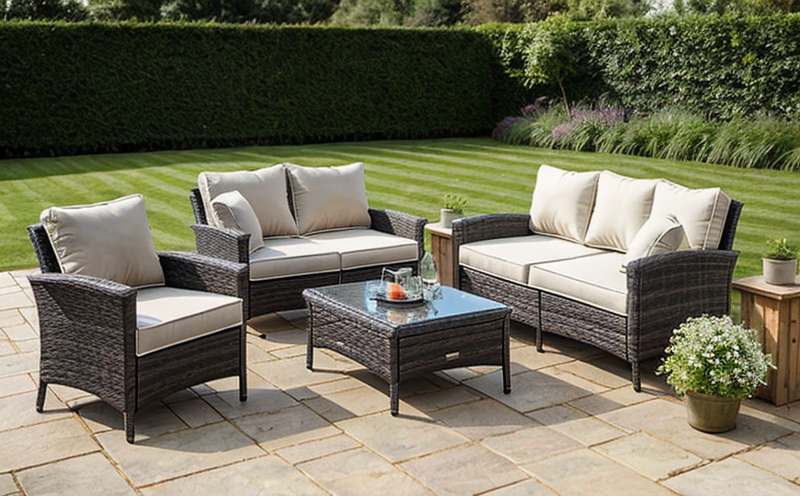ASTM F1858 Stability and Structural Integrity of Outdoor Chairs Testing
The ASTM F1858 standard specifies procedures to determine the stability and structural integrity of outdoor chairs. This testing is essential for manufacturers, quality managers, compliance officers, and R&D engineers ensuring the safety and durability of products intended for use in outdoor environments.
Outdoor furniture must withstand harsh weather conditions such as rain, snow, wind, and temperature fluctuations. The ASTM F1858 stability test simulates real-world stresses to assess whether a chair can maintain its structural integrity without collapsing or tipping over. Compliance with this standard is crucial for manufacturers aiming to meet regulatory requirements and ensure consumer safety.
The testing procedure involves subjecting the chair to various forces that mimic outdoor use scenarios, including static loads at the seat and backrest, dynamic loading tests, and environmental exposure tests. This ensures that the furniture can support users safely under both static and dynamic conditions.
For accurate assessment of stability, it is important to prepare specimens correctly before testing. Specimens should be clean, free from defects or damage, and representative of the final product. The test setup typically includes a calibrated load cell for measuring force distribution accurately.
The ASTM F1858 standard provides detailed acceptance criteria based on visual inspection and structural performance data. A chair passes if it remains stable under specified loading conditions without any visible signs of failure such as cracking, bending, or collapse.
Manufacturers often use this test to validate product design improvements or to ensure consistent quality across production batches. By conducting regular stability tests, companies can identify potential issues early in the development process and make necessary adjustments before mass production begins.
The ASTM F1858 stability test is just one part of a comprehensive suite of outdoor furniture testing services offered by reputable laboratories. Other relevant standards include ASTM D6473 for weathering resistance and ASTM F2097 for impact performance, which together provide a robust framework for ensuring product safety and durability.
In conclusion, compliance with the ASTM F1858 stability test is not just about meeting industry expectations; it's also about protecting end-users from potential hazards associated with unstable or poorly constructed outdoor furniture. By investing in rigorous testing procedures early on, manufacturers can build trust with consumers while reducing liability risks down the line.
Applied Standards:
| Standard | Description |
|---|---|
| ASTM F1858 | Procedure for determining the stability and structural integrity of outdoor chairs. |
| ASTM D6473 | Guide on accelerated weathering tests for polymeric materials intended to be exposed outdoors. |
| ASTM F2097 | Standard test method for impact performance of outdoor furniture using a falling weight pendulum. |
Industry Applications:
- Outdoor furniture manufacturers ensuring product safety and compliance with international standards.
- Compliance officers verifying that products meet specific regulatory requirements related to stability.
- R&D engineers refining designs based on test results to enhance both aesthetic appeal and functional performance.
Why It Matters
The importance of ASTM F1858 testing cannot be overstated, especially given the increasing popularity of outdoor living spaces. With more people spending time outdoors, there is a growing demand for safe, reliable, and stylish furniture that can withstand various environmental factors.
One key aspect where this test matters is ensuring the structural integrity of outdoor chairs during heavy use. According to ASTM, failing a stability test could lead to accidents involving users, posing significant risks both physically and legally.
Another critical consideration is durability. Environmental elements like sunlight, rain, and wind can cause materials used in outdoor furniture to degrade rapidly. The ASTM F1858 stability test helps identify which materials are most resistant to these conditions, allowing manufacturers to choose the best options for their products.
From a business perspective, meeting such standards enhances brand reputation by demonstrating commitment to quality control and user safety. It also opens up opportunities for international markets where compliance with local regulations is mandatory.
In summary, ASTM F1858 stability testing plays an integral role in safeguarding consumers while promoting responsible manufacturing practices within the industry.
Applied Standards
| Standard | Description |
|---|---|
| ASTM F1858 | Procedure for determining the stability and structural integrity of outdoor chairs. |
| ASTM D6473 | Guide on accelerated weathering tests for polymeric materials intended to be exposed outdoors. |
| ASTM F2097 | Standard test method for impact performance of outdoor furniture using a falling weight pendulum. |
The ASTM F1858 stability test is part of a broader set of guidelines designed to ensure that outdoor furniture meets stringent quality standards. These include:
- ASTM D6473, which covers accelerated weathering tests for polymeric materials.
- ASTM F2097, which deals with impact performance using a falling weight pendulum.
By adhering to these standards, manufacturers can guarantee that their products will perform reliably under challenging outdoor conditions. This commitment to excellence helps build consumer confidence and fosters long-term brand loyalty.
Industry Applications
- Outdoor furniture manufacturers ensuring product safety and compliance with international standards.
- Compliance officers verifying that products meet specific regulatory requirements related to stability.
- R&D engineers refining designs based on test results to enhance both aesthetic appeal and functional performance.
The ASTM F1858 stability test is widely used across various segments of the outdoor furniture market. From residential settings where homeowners seek durable pieces that last through seasons, to commercial applications like hotels and resorts which require high traffic tolerance, this testing ensures reliability under all circumstances.
Furthermore, compliance with these tests can open doors to new markets internationally, particularly those with stringent safety regulations regarding outdoor products. By demonstrating adherence to global standards early on, manufacturers position themselves favorably against competitors who may not meet similar criteria.





